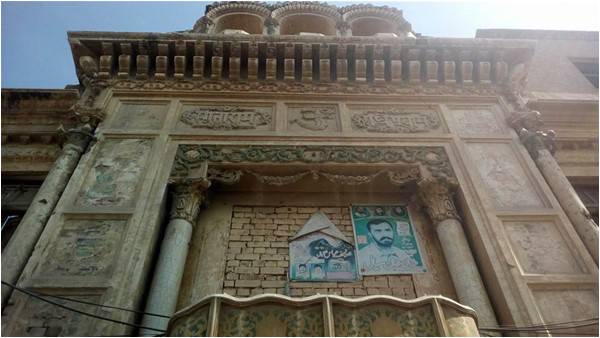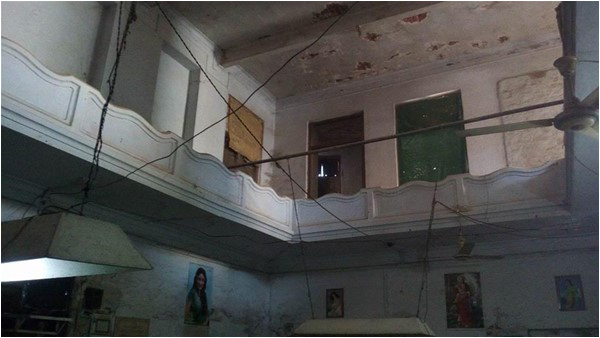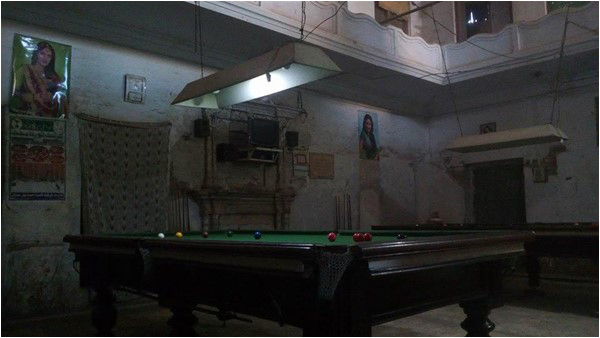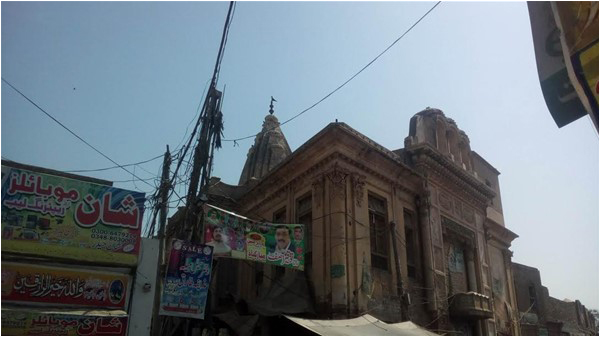
The Sita Ram temple in Ahmadpur Sial tehsil of Jhang district is one of the landmarks in architecture from the 19th century in that region. But due to certain political factors and decades of neglect, it seems on the verge of collapse. Moreover, the building of the temple has been leased out to an individual who has turned it into a snooker club!
Ahmedpur Sial, a sub-district of Jhang district was once a Hindu-majority town with several temples and other places of worship. The town had three big temples, two Dharmashalas (religious sanctuaries), one Gaushala (for the cows) and an orphanage. The Sita Ram temple is still standing but the building is in shambles and is being rented out to a local by the department of Non-Muslim Evacuee Trust, Jhang.

Inside Sita Ram’s Hindu Temple, located in the Mandir Square (Mandir Chowk), there is little that sets it apart from an abandoned building. Furnished with a snooker table and with a few benches, the only thing that reveals it to be a temple are the words written in Gurmukhi script at the front of the building and its old architecture.
A local historian Saifullah Siddiqui from Ahmedpur Sial says the pre-Partition temple, which was built in 1887 and was once frequented by a community of thousands of Hindus. Today it may be used as a snooker club, but before the Partition, Hindu people would celebrate a grand festival annually in which pilgrims from across the region would participate.
He says the Sita Ram temple was considered one of the most significant temples in the pre-Partition era. The main door of the temple, which was made of wood and bore pictures of Hindu deities on its four corners, is missing now.

Siddiqui says a violent mob attacked the temple following the attack on Babri Mosque in India, in 1992. However, the local administration of the temple was able to dissuade the mob from causing much destruction to the temple.
He says it is not a temple anymore but a crowded place where vendors are selling items of daily use. Most of the valuables inside the temple were stolen by locals. Until the 1980s, what is now Mayo Chowk was known as Mandir Chowk. After a public campaign, authorities changed the name of the square to Mayo Chowk.
“The Sita Ram temple has lost its beauty – as, unfortunately, has happened to many Hindu worship places in Pakistan,” he adds.
Rana Tauqeer, who runs the snooker club, says the department of Non-Muslims Evacuee Trust leased out the building to him. He says most of the Hindu religious worship places have been rented out to people for different purposes by the department because now there are no Hindus in residence. He says portions of the Sita Ram temple are now being used as shops by local people and that it doesn’t look like a temple anymore.

Local journalist Ansar Baloch says Pakistan’s first prime minister Liaquat Ali Khan and the then Indian prime minister signed an agreement after the 1947 Partition that both the countries would protect religious sites but unfortunately, political realities of post-Partition history have changed the course of life for Hindus in Pakistan.
Baloch asks: “What greater injustice can be done to the history of the land when a building built 130 years ago has been leased out to an individual - just for few thousands rupees? There are dozens of ways in which the building can be preserved and used in a much better way.”
He says the protection of the lives and properties of minorities is the responsibility of the government. “It is shameful that a historical Hindu temple is being used as a sports facility. The Non-Muslim Evacuee department must take it back, renovate it and declare it a national heritage site” he believes.
The President of All Pakistan Hindus Rights Movement, Haroon Sarbadyal, points out that what has happened to the Sita Ram temple in Ahmedpur Sial is the story of almost every other Hindu temple in Pakistan. “The Non-Muslim Evacuee Trust responsible for the preservation of temples and Gurdwaras has failed miserably in every province of the country to protect the national heritage. Some temples have been turned into madrassas, some are left to be encroached upon by people and some have been grabbed by the land mafia,” he says.
Sarbadyal further adds: “It is time we showed the world that we are a civilised nation and that we care for our heritage. We should not be ashamed of our history because it is the beauty of our society!” He urges the Punjab government to consider all the temples, Gurdwaras and other historical religious sites to be a vital part of national heritage – with appropriate funds to restore them to their glory.
Assistant Administrator of Non-Muslim Evacuee Trust district Jhang, Riaz Ahmed, says all the non-functional Hindu temples, Gurdwaras and other places of worship have been leased out to generate revenue and that this, in a way, ensures they would be protected. The department lacks the money to protect or renovate each historical building, according to him.
The assistant administrator further adds that the decision to rent out the historical buildings in the district was taken at a meeting of the department.
“What else can be done with such non-functional buildings?” he asks.
Ahmedpur Sial, a sub-district of Jhang district was once a Hindu-majority town with several temples and other places of worship. The town had three big temples, two Dharmashalas (religious sanctuaries), one Gaushala (for the cows) and an orphanage. The Sita Ram temple is still standing but the building is in shambles and is being rented out to a local by the department of Non-Muslim Evacuee Trust, Jhang.

Inside Sita Ram’s Hindu Temple, located in the Mandir Square (Mandir Chowk), there is little that sets it apart from an abandoned building. Furnished with a snooker table and with a few benches, the only thing that reveals it to be a temple are the words written in Gurmukhi script at the front of the building and its old architecture.
A local historian Saifullah Siddiqui from Ahmedpur Sial says the pre-Partition temple, which was built in 1887 and was once frequented by a community of thousands of Hindus. Today it may be used as a snooker club, but before the Partition, Hindu people would celebrate a grand festival annually in which pilgrims from across the region would participate.
He says the Sita Ram temple was considered one of the most significant temples in the pre-Partition era. The main door of the temple, which was made of wood and bore pictures of Hindu deities on its four corners, is missing now.

"Some temples have been turned into madrassas, some are left to be encroached upon by people and some have been grabbed by the land mafia"
Siddiqui says a violent mob attacked the temple following the attack on Babri Mosque in India, in 1992. However, the local administration of the temple was able to dissuade the mob from causing much destruction to the temple.
He says it is not a temple anymore but a crowded place where vendors are selling items of daily use. Most of the valuables inside the temple were stolen by locals. Until the 1980s, what is now Mayo Chowk was known as Mandir Chowk. After a public campaign, authorities changed the name of the square to Mayo Chowk.
“The Sita Ram temple has lost its beauty – as, unfortunately, has happened to many Hindu worship places in Pakistan,” he adds.
Rana Tauqeer, who runs the snooker club, says the department of Non-Muslims Evacuee Trust leased out the building to him. He says most of the Hindu religious worship places have been rented out to people for different purposes by the department because now there are no Hindus in residence. He says portions of the Sita Ram temple are now being used as shops by local people and that it doesn’t look like a temple anymore.

Local journalist Ansar Baloch says Pakistan’s first prime minister Liaquat Ali Khan and the then Indian prime minister signed an agreement after the 1947 Partition that both the countries would protect religious sites but unfortunately, political realities of post-Partition history have changed the course of life for Hindus in Pakistan.
Baloch asks: “What greater injustice can be done to the history of the land when a building built 130 years ago has been leased out to an individual - just for few thousands rupees? There are dozens of ways in which the building can be preserved and used in a much better way.”
He says the protection of the lives and properties of minorities is the responsibility of the government. “It is shameful that a historical Hindu temple is being used as a sports facility. The Non-Muslim Evacuee department must take it back, renovate it and declare it a national heritage site” he believes.
The President of All Pakistan Hindus Rights Movement, Haroon Sarbadyal, points out that what has happened to the Sita Ram temple in Ahmedpur Sial is the story of almost every other Hindu temple in Pakistan. “The Non-Muslim Evacuee Trust responsible for the preservation of temples and Gurdwaras has failed miserably in every province of the country to protect the national heritage. Some temples have been turned into madrassas, some are left to be encroached upon by people and some have been grabbed by the land mafia,” he says.
Sarbadyal further adds: “It is time we showed the world that we are a civilised nation and that we care for our heritage. We should not be ashamed of our history because it is the beauty of our society!” He urges the Punjab government to consider all the temples, Gurdwaras and other historical religious sites to be a vital part of national heritage – with appropriate funds to restore them to their glory.
Assistant Administrator of Non-Muslim Evacuee Trust district Jhang, Riaz Ahmed, says all the non-functional Hindu temples, Gurdwaras and other places of worship have been leased out to generate revenue and that this, in a way, ensures they would be protected. The department lacks the money to protect or renovate each historical building, according to him.
The assistant administrator further adds that the decision to rent out the historical buildings in the district was taken at a meeting of the department.
“What else can be done with such non-functional buildings?” he asks.

